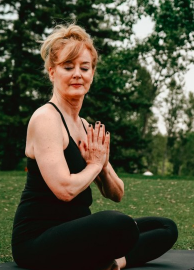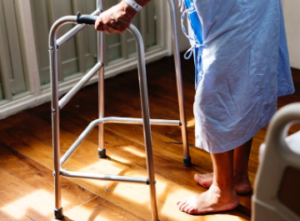Fall Prevention
Each year more than 33% of adults over the age of 65 fall. The most serious injury related to these falls is a hip fracture. Only 50% of elderly people who are hospitalized with a broken hip after a fall are able to return home to live independently after their injury.
Why is fall prevention so important? Once a person has fallen once they tend to develop a fear of falling which limits their activities and ultimately increases their risk of falling even more. It seems odd but the more a person fears falling, the more limited their movements are (self limited), therefore they become weaker and ultimatley more likely to fall. They may even stop getting up out of the easy chair to get lunch or use the bathroom, which adds other risks including potential for skin breakdown and nutrition issues. Falls in the elderly population are a major reality contributing to serious injuries and hospital stays.
How can you help prevent falls from happening?
There are many different areas that can be addressed to help reduce the likelihood of a fall. To have a successful plan to prevent falls you should incorporate medical care, exercise and environment. The following suggestions can be combined to create your own personal fall prevention plan or a plan for someone you know who may have factors that put them at risk for falling.
Preventing Falls in the Elderly Population:
*Lighting
Have ample lighting in rooms and hallways with switches at the entrance to each room.
Use night lights in bedrooms,stairways, hallways and bathrooms.
Eliminate glare by using shades or frosted bulbs.
Consider using remote control light switches.
*Floors, hallways and stairs
Move electrical cords so they are not lying in main walking areas.
Fasten rugs firmly to floors and use nonskid backing. Tack down loose ends.
Remove or replace carpeting over thresholds to create smooth transitions between rooms.
Remove clutter – including piles of shoes and/or newspapers.
Only use stairs with handrails on both sides for support.
Repair worn carpet on steps.
Apply nonskid treads to steps.
Use color-contrasted nonskid tape for additional contrast on steps and landings.
Assure that steps are evenly spaced.
Avoid waxed or polished floors.
*Furniture
Arrange furniture so that pathways are not obstructed.
Make sure furniture is sturdy – not wobbly.
Replace low chairs with higher chairs that are easier to get up from and sit down in.
Use chairs with armrest supports or get a lift assist chair.
Add a seat cushion to raise the seat height if needed.
*Storage
Keep frequently used items at waist height.
Use a long handled reacher to obtain objects out of reach.
Install shelves and cupboards at an accessible height.
*Kitchens and Bathrooms
Place kitchen items within easy reach and avoid storing any items too high or too low.
If you use a step stool, make sure it has a high handle to hold on to.
Keep heavier items on lower shelves.
Use an elevated toilet seat or install a safety frame.
Install grab bars in the tub/shower or use a shower chair.
Apply nonskid strips to the floor and inside the tub/shower.
Avoid using bar soap – use liquid from a dispenser instead.
Put handrails in dressing, shower and toilet areas.
*General Care and Precautions
Wear shoes with firm nonskid soles. Avoid loose-fitting slippers that can lead to tripping.
Only wear low-heeled shoes.
Avoid risky behavior, such as standing on a ladder unaided.
Always rise slowly and avoid rushing.
Avoid clutter.
 *Your Health
*Your Health
Talk to your Doctor about any concerns you have including a fear of falling.
Eat well-balanced, nutritious meals.
Perform moderate weight bearing exercises on a regular basis.
Avoid alcohol.
See an Ophthalmologist (eye doctor) at least once per year.
Take care of your feet. Have them examined if they are painful when walking.
Ask about medications that might cause dizziness or fainting.
Use a cane or walker if it is recommended for you.
Contact your physician with any health concern and after any fall.
*Balance Screening
If your local Community Center of Health Center offers free balance screening take advantage of it. The purpose of Balance Screening and Fall Prevention Programs is to identify the risk factors and modify them to provide a safe environment for older adults. These programs are a useful tool to improve quality of life and emotional and physical well-being. The goal is to help aging people continue as active and safe participants in their lives, with their families and within their communities.
In Conclusion
As we age we become more and more likely to fall. As you can see there are many, many things you can do to help ensure you are less likely to experience a fall. Some of these things are really quick and inexpensive like picking up certain items. Other things mentioned here are a little more difficult and can take time, like starting an exercise program to increase strength and balance.
It is well worth your time and attention to make these modifications to limit your chance of falling The impact of a fall can be life altering or even life ending. Our goal is help you stay safe and independent at home for as long as you wish to do so.



Heather, thanks for this post. I knew nothing about this topic. There is an elderly woman living next door to me. She is kind, always wanting to bake cookies and cakes for someone. She doesn’t have family to look after her. She fell the other day. And after reading your post I’m going over and look at her home and see if I can make it a safer place for her.
Another thing I thought of is to use, I’m not sure what they are call, one of those things you hang around your neck that when you fall you press a button and it calls for help. Is it a medical responder? Don’t know the name. But that would make a safer environment, because most of them can be used wherever you go. Good post. Very informative.
All the best to you,
Don
She is so fortunate to have you as a neighbor Don. Thanks for looking out for someone who needs you. The item you are thinking of could be Lifeline although there are others too. All the best to both of you!